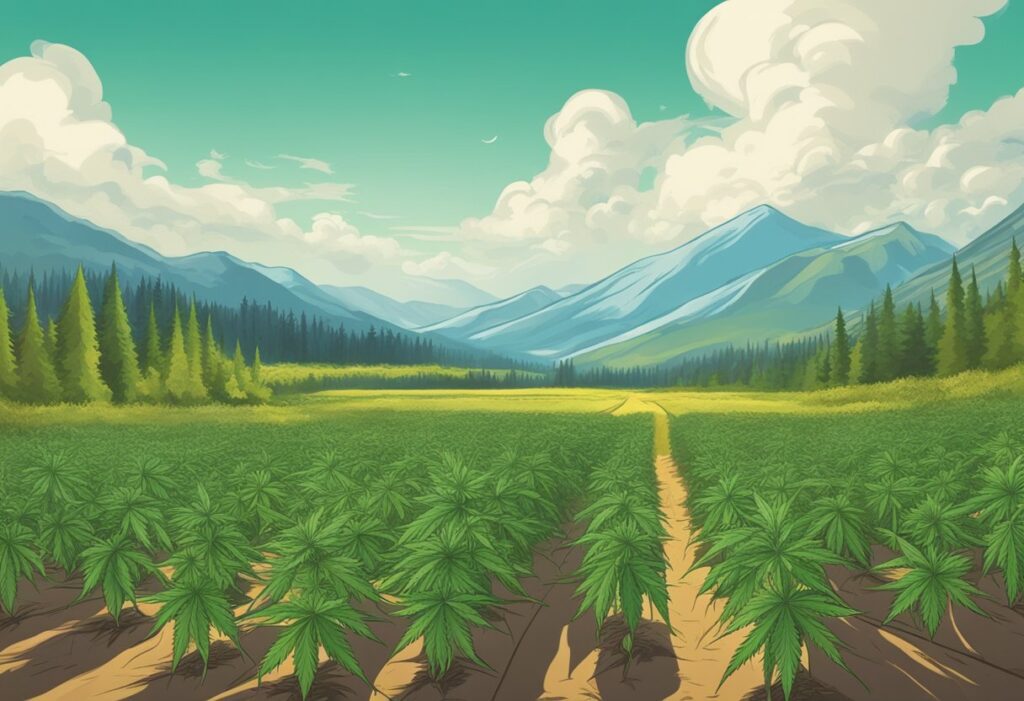
In Canada, cannabis cultivation has evolved significantly since its legalization in 2018, with the industry facing both regulatory and environmental challenges.
With the enactment of the Cannabis Act in October 2018, you are allowed to legally cultivate cannabis for recreational use. Each household can grow up to four plants. However, the provinces and territories have the authority to implement further regulations, which may affect your ability to cultivate cannabis at home.
Cannabis farming in Canada is not evenly distributed due to differing provincial regulations and climate conditions. The majority of large-scale production is found in provinces with favorable climates, such as British Columbia and Ontario. You will find these farms varying in size from small artisanal growers to large agro-industrial facilities.
As a cultivator, understanding and implementing environmental sustainability practices is crucial due to the substantial water and energy requirements of cannabis production. The industry is increasingly focusing on reducing carbon footprints and mitigating negative environmental impacts, such as water pollution and habitat disruption. Your practices significantly affect the surrounding ecosystems, and thus, adhering to sustainable cultivation methods is essential for the long-term viability of the cannabis industry in Canada.

Climate change alters key environmental parameters affecting your cannabis cultivation efforts in Canada, from temperature shifts to water availability.
As climate change continues to disrupt weather patterns, you may notice significant shifts in the growing seasons for cannabis. You’re likely to face warmer temperatures and changing precipitation rates, leading to modified planting and harvesting schedules. These changes force you to adapt to prevent potential yield reduction.
When growing cannabis outdoors, increased risk of pests and diseases due to climate change is a major concern. In greenhouses, enhanced energy consumption for heating or cooling might strain your operation’s sustainability and economic viability due to the demand for temperature control amid shifting exterior climate conditions.
To mitigate the negative impacts of climate change on your cannabis cultivation, consider adopting various adaptation strategies.

In Canada, government policies have a profound impact on cannabis farming, with implications spanning environmental, public health, and economic domains.
The Government of Canada has implemented environmental regulations aimed at minimizing the impact of cannabis production on the environment. You need to be aware that these regulations govern aspects such as water usage, waste management, and the reduction of greenhouse gas emissions. Cannabis farms must comply with these policies to ensure that their operations do not detrimentally affect local ecosystems or contribute to climate change.
Public health is a significant concern in the regulation of cannabis production in Canada. Your cannabis farms are subject to strict quality control measures to ensure product safety for consumers. These policies cover everything from the use of pesticides to product testing to make sure that cannabis is free from contaminants.
Since the legalization of cannabis, you face both economic opportunities and challenges. Governing policies affect your business operations, from licensing fees to the security measures you must employ to protect your crops. Legalization has opened up new markets, but it also means you have to navigate tax regulations and compliance with quality assurance protocols.
Remember, adherence to these policies not only affects your environmental footprint and the safety of your products but also plays a critical role in the economic viability of your operation.
Shifts in temperature and precipitation patterns can directly influence cannabis yield and quality. Warming temperatures may extend the growing season for some cultivators, but they also increase the risk of heat stress and pests that may negatively affect plant health and cannabinoid profiles.
As climate change progresses, the marijuana industry may face significant disruptions due to water scarcity, altered growing seasons, and increased frequency of extreme weather events. These factors could lead to volatility in production levels and cannabis market prices.
Cultivators are exploring adaptive strategies such as using drought-resistant cannabis strains, implementing water-efficient irrigation technologies, and adjusting planting schedules to adapt to changing climate patterns, thus securing yields and quality.
Extreme weather events, such as storms and wildfires, can devastate outdoor cannabis farms resulting in crop loss and reduced annual yields. These events also raise the importance of disaster preparedness and risk mitigation in cultivation planning.
Industrial cannabis growth in controlled environments can lead to energy-intensive operations, thereby increasing carbon emissions. However, some benefits include the ability to grow year-round, optimize resource use, and potentially use renewable energy sources to offset carbon footprints.
We ship and deliver world wide via USPS and various couriers.
We offer a wide range of secure and anonymous online payment options.
We care about you, our customer. Please contact us with any questions or concerns.
Find out more about the benefits of being a loyal and regular customer.
WE ARE EVERY GROWERS ONE STOP SHOP TO ACQUIRE PREMIUM CANNABIS SEEDS FOR SALE IN THE USA, CANADA AND AUSTRALIA

Farmers Lab Seeds 2024, | All Right Reserved
Seeds are sold as novelty items, souvenirs, and collectibles. They contain 0% THC. We encourage our customers to check the legislation in their Country, State, Province, and Municipality prior to purchasing items from our store. We do not provide growing information.
All seeds are sold as hemp, and lab tested under 0.3% THC. This product is not for use by or sale to persons under the age of 21. This product should be used only as directed on the label. It should not be used if you are pregnant or nursing. Consult with a physician before use if you have a serious medical condition or use prescription medications. A Doctor’s advice should be sought before using this and any supplemental dietary product. All trademarks and copyrights are property of their respective owners and are not affiliated with nor do they endorse this product.
These statements have not been evaluated by the FDA. This product is not intended to diagnose, treat, cure or prevent any disease. Individual weight loss results will vary. By using this site, you agree to follow the Privacy Policy and all Terms & Conditions printed on this site. Void Where Prohibited by Law.